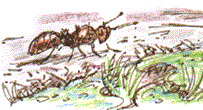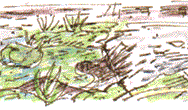Nature Diary Rocks History Gallery Links Home Page    REPAINTING THE FRONT DOOR, I glimpse the secret world that's right there on my doorstep. There's a science fiction landscape of primitive plants with unlikely life cycles. It is inhabited by mysterious creatures, living in a sensory world that would be alien to ourselves.
REPAINTING THE FRONT DOOR, I glimpse the secret world that's right there on my doorstep. There's a science fiction landscape of primitive plants with unlikely life cycles. It is inhabited by mysterious creatures, living in a sensory world that would be alien to ourselves.A forest of Liverworts grows in a crack between the paving stones. The crack is a miniature valley providing the damp microclimate the liverwort needs. I've never noticed it before, despite walking over it every day. This primitive plant has no distinct leaf or stem. It consists of a flat pad scalloped like a liver. Growing amongst it, like miniature grasses, are bright green tufts of moss. Although these relatives of the liverworts have distinct leaves and stems they have no proper roots. A lone ant scurries across this miniature landscape. Somewhere nearby the mysterious life of the ant colony is in progress, with its social order of queens, workers and winged males. Although the ant has eyes its world map is mainly one of scent trails. The act of sharing food is what drives the colony and holds it together. You could argue that in the ant world it is the colony not the individual ant that is the real animal. I disturb a number of spiders as I prepare to paint. While ants have evolved to make the most of being one of many, the spiders are individualists. Amongst the five or six hundred different species of spider in Britain there are a number of different strategies for hunting or trapping prey. I pull at a small Dandelion. The leaves break off, leaving the taproot in the crack. White latex oozes from the break. In the Second World War the Germans experimented to see if this latex could be extracted to yield a supply of rubber.
|